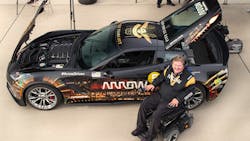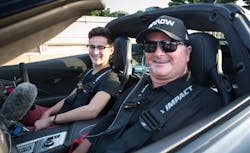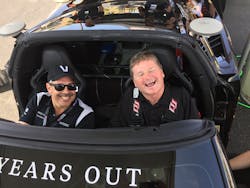An internet search for news headlines about Sam Schmidt’s near-fatal car crash back in 2000 yields a string of results decrying the probability that the racing car driver would ever take the wheel again.
But the former Indy Racing League driver, who made 27 career starts and won at the Las Vegas Motor Speedway in 1999, would defy the odds and prove the headlines wrong.
Collaborating with a team of engineers at Arrow Electronics to launch the semi-autonomous motorcar (SAM) project, Schmidt would not only become the first person with quadriplegia to receive an autonomous vehicle driver’s license, but would have the gumption to challenge the iconic Mario Andretti at the Indianapolis Motor Speedway—albeit using only his head to control the vehicle.
Off to a Good Start
The SAM project launched in 2013 with a collaboration between a group of engineers and medical researchers, including Arrow Electronics, Ball Aerospace & Technologies Corp., Falci Adaptive Motorsports and the Air Force Research Laboratory.
The goal was to modify a car to be safely driven at speed by a quadriplegic race driver using only head movements, says Joe Verrengia, director of Corporate Social Responsibility, Arrow Electronics, a Fortune 500 that specializes in distribution and value-added services relating to electronic components.
“We realized that even though we work with the medical industry and the medical device industry, there are just years and years of regulation and approval for that,” Verrengia explains. “We wanted to demonstrate how quickly people’s lives could be changed and improved.”
At the time, autonomous vehicles from various companies were making their way to the road. What differentiated the SAM car was its focus on the driver, and the ambition to improve mobility for people with physical disabilities.
According to the U.S. Census Bureau, nearly one in five Americans have a disability due to injuries, illness, aging or other factors. Verrengia says the SAM car project brings awareness to this reality and challenges the innovator community to “take a hard look at what they can do quickly to help people.”
Accoridng to Verrengia, the project’s philosophical and CSR origins is rooted in the idea that driving can have a profound effect on one’s sense of self and opens up new possibilities. “Talking with people confined to wheelchairs, especially people like our driver Sam Schmidt, we found that they’ll use autonomous cars because it will be convenient. It will help with their mobility. For them, it’s not an act of independence. It’s not just a demonstration of freedom.”
Staying on Track
The SAM car has undergone multiple iterations since 2013, but the current vehicle is a modified 2018 Corvette Z06 with semi-autonomous technology. At the heart of the autonomous system is the SAM computer, which tracks the motion and subtle head movements of Schmidt’s movements in real-time. The vehicle is controlled independently by Schmidt and is not under computer control.
In essence, Schmidt controls the Corvette on a racetrack or on city streets using a combination of head controls and voice commands to navigate and switch gears. The car is designed with two separate systems: The first translates Schmidt’s input into steering, as well as gas and brake output. The second is a drive-by-wire system, which augments traditional mechanical controls. Arrow Electronics has yet to patent the autonomous technology used in the vehicle.
“We’ve used an off-the-shelf paraplegic vehicle control system used by manufacturers that modify cars for hand control,” says Josh Willis, a field-applications engineer. “Except, they’ve opened up their interface to us.” Willis was brought onto the project in 2016 to help build a car specifically targeted to take on the harrowing twists and hairpin turns of the Pikes Peak Hill Climb, the second oldest automotive race in the United States stretching 12.42 miles.
Steering the Vehicle
In the driver’s seat, Schmidt wears sunglasses with reflective markers. Infrared cameras mounted on the dashboard detect Schmidt’s head motions. He simply needs to look in the direction he wants to go to steer the vehicle. Off-the-shelf motion capture software log the pattern of dots trapped by the IR cameras from the sunglasses. When Schmidt pivots his head, the cameras and sensors extract only the angle of his head.
“All that matters is the orientation of the glasses. We extract the exact angle and then turn the wheel accordingly,” explains Willis. “We’re using the same motion analysis software used in film animation such as Pixar, or used by doctors when tracking the skeletons of athletes as they run on treadmills. We’re just using the software in a way that no one else has used it.”
A sip-and-puff device enables Schmidt to accelerate and brake. To speed up, he exhales into a mouthpiece fitted with a pressure sensor. A rotary actuator attached to the gas pedal responds to Schmidt’s input, ranging from a gradual increase to a quick burst of speed. The harder Schmidt puffs, the stronger the acceleration rate. And to bring the vehicle to a halt, Schmidt sips on a straw, which creates negative pressure and translates into braking.
The system is intuitive and it doesn’t take much to learn how to operate the vehicle, says Willis. “The hardest thing to remember is which one’s gas, and which is brakes. As soon as you start doing it, you build up a little muscle memory.”
Ironically, learning to drive the vehicle is harder on someone like Schmidt. As a trained race-car driver, he tends to look further ahead on the track, as opposed to focusing his eyes in a way that captures his immediate vicinity. “Instead of looking at the entry to the turns, race-car drivers are already looking towards the exit,” says Willis. That actually becomes a bit of a limitation in our system. It’s a little harder for a race-car driver in some ways than it is the average person.”
Safety First
Safety features were considered early in the project. The SAM team considered using GPS to geofence the racetrack and trigger lane departure warnings that would force Schmidt to drive within demarcated zones. But with a penchant for speed, Schmidt is inclined to push the car to its limits. Rather than stay in the middle of the track, he wanted to take the exact racing line, which was with the mirror positioned 4 in. from the wall and the tire right on the edge of the pavement on the inside.
In this scenario it would be hard to use software to implement the safety mechanisms, says Willis. Instead, the team chose to install co-driver controls to the right seat of the vehicle and have another professional driver act as a co-driver during high-speed events. The co-driver’s role is to be on the lookout for a mistake from Schmidt, a health issue or a system failure. The steering, gas and brake on the passenger side can help the car recover from an event.
In addition, the computer system pulls data about the car’s performance, including handling, speed and temperature, while sensors gather data to monitor Schmidt’s heart rate and body temperature. The drive-by-wire systems are certified by the automotive industry, adds Willis. “They’re all triple-redundant and very safe and reliable.”
With these precautions in place, Schmidt has reached a top speed of 192 mph on the runway, and navigated multiple drives at Indy and other professional race tracks.
Break Down Barriers
While the SAM car is a humanitarian technology project and a demonstration, there are promising broader applications for independent living, says Verrengia.
Firstly, it breaks down barriers by showing that it doesn’t take a lot to help someone with limited mobility become more mobile. For the past two years, Arrow has collaborated with Schmidt’s non-profit Conquer Paralysis Now and his DRIVEN NeuroRecovery Center in Southern Nevada, to help people disabled by military combat, spinal cord injuries, illness and aging to experience similar freedom in the Arrow SAM car on closed courses.
Secondly, it is often assumed the R&D horizon is long and the impact from new solutions tends to be far off, but Verrengia says that’s not always the case. Schmidt’s drive and philanthropic successes in paralysis research demonstrate the possibilities and knock-on effects.
And thirdly, “there’s a lot of inherent power in things that have already been invented—you just need to apply it in new ways,” says Verrengia. While the technology and software that Arrow developed is unique, it consists of off-the-shelf components that were originally developed and commercialized for other purposes. To boot, it is open for the developer and engineering communities.
“We purposely did not set out to invent any new hardware for this project, and it has taught us an important lesson: that there’s technology today that could help in a lot of different ways that might not be its original commercial purpose,” says Verrengia. “But with a little bit of ingenuity, the world can change.”
About the Author

Rehana Begg
Editor-in-Chief, Machine Design
As Machine Design’s content lead, Rehana Begg is tasked with elevating the voice of the design and multi-disciplinary engineer in the face of digital transformation and engineering innovation. Begg has more than 24 years of editorial experience and has spent the past decade in the trenches of industrial manufacturing, focusing on new technologies, manufacturing innovation and business. Her B2B career has taken her from corporate boardrooms to plant floors and underground mining stopes, covering everything from automation & IIoT, robotics, mechanical design and additive manufacturing to plant operations, maintenance, reliability and continuous improvement. Begg holds an MBA, a Master of Journalism degree, and a BA (Hons.) in Political Science. She is committed to lifelong learning and feeds her passion for innovation in publishing, transparent science and clear communication by attending relevant conferences and seminars/workshops.
Follow Rehana Begg via the following social media handles:
X: @rehanabegg
LinkedIn: @rehanabegg and @MachineDesign




